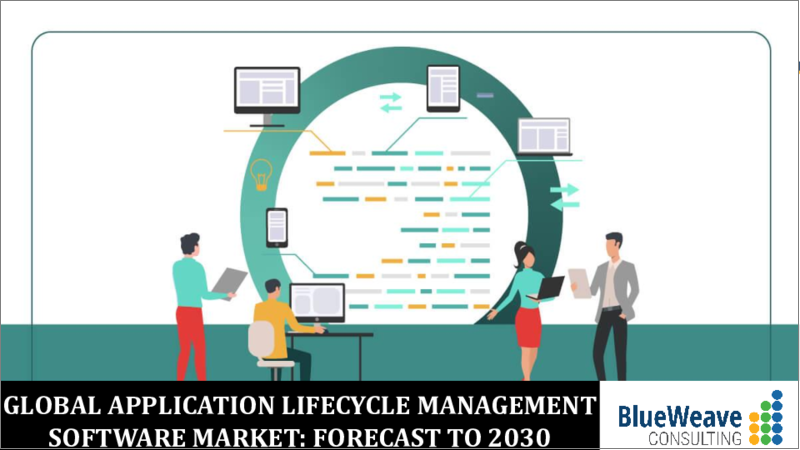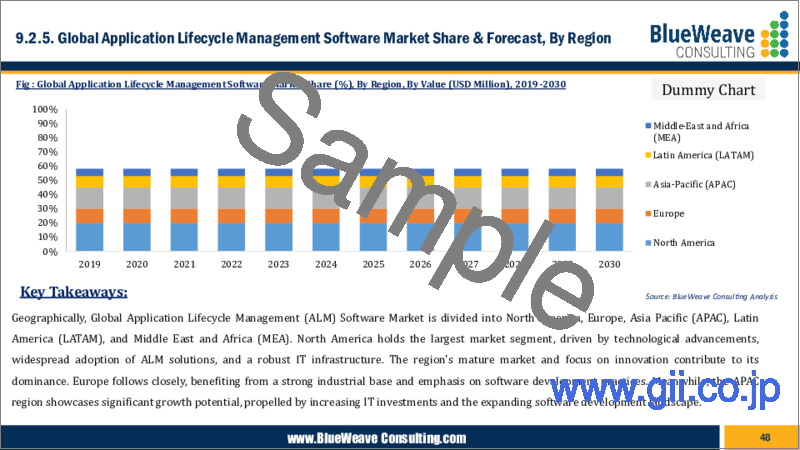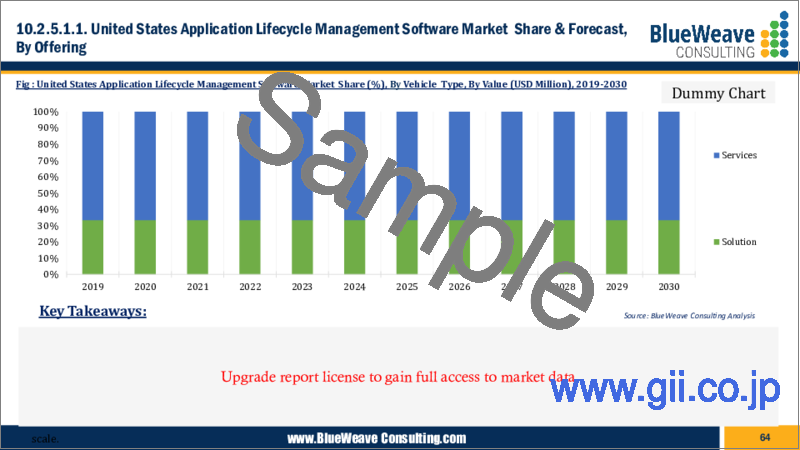|
|
市場調査レポート
商品コード
1410966
アプリケーションライフサイクル管理(ALM)ソフトウェア市場- 世界の規模、シェア、動向分析、機会、予測レポート、2019-2029年Application Lifecycle Management Software Market - Global Size, Share, Trend Analysis, Opportunity and Forecast Report, 2019-2029, Segmented By Offering ; By Deployment Model ; By Organization Size ; By Application ; By Region, |
||||||
|
|||||||
| アプリケーションライフサイクル管理(ALM)ソフトウェア市場- 世界の規模、シェア、動向分析、機会、予測レポート、2019-2029年 |
|
出版日: 2024年01月02日
発行: Blueweave Consulting
ページ情報: 英文 400 Pages
納期: 2~3営業日
|
- 全表示
- 概要
- 目次
アプリケーションライフサイクル管理(ALM)ソフトウェアの世界市場規模は安定したCAGRで拡大、2029年までに56億8,000万米ドルに達する
アプリケーションライフサイクル管理(ALM)ソフトウェアの世界市場は、効率的なソフトウェア開発プロセスに対する需要の高まり、アジャイル手法の採用の増加、ソフトウェアプロジェクトの複雑化、開発チーム間のコラボレーションの必要性、製品品質と市場投入期間の強化への注力などにより、活況を呈しています。
戦略コンサルティングと市場調査の大手企業であるBlueWeave Consulting社は、最近の調査で、2022年の世界のアプリケーションライフサイクル管理(ALM)ソフトウェア市場規模を37億5,000万米ドルと推定しました。2023年から2029年にかけての予測期間において、アプリケーションライフサイクル管理(ALM)ソフトウェアの世界市場規模はCAGR 7.16%で成長し、2029年には56億8,000万米ドルに達するとBlueWeave社は予測しています。アプリケーションライフサイクル管理(ALM)ソフトウェアの世界市場は、ソフトウェア開発プロセスの合理化、開発チーム間のコラボレーション改善、効率的なプロジェクト管理の必要性に対する需要の高まりが主な要因となっています。ソフトウェア・アプリケーションの複雑化とアジャイル開発手法の重視の高まりが、ALMソフトウェアの採用を後押ししています。また、ALMソリューションに人工知能や機械学習のような先進技術が統合されたことで、ALMの機能がさらに強化されています。企業が市場投入までの時間を短縮し、製品品質を向上させようと努力する中、ALMソフトウェア市場は、効果的なソフトウェア開発ライフサイクル管理の必要性に後押しされ、力強い成長を続けています。
本レポートの詳細な分析により、世界のアプリケーションライフサイクル管理(ALM)ソフトウェア市場の成長可能性、今後の動向、統計に関する情報を提供します。また、市場規模の予測を促進する要因にも注目しています。当レポートは、世界のアプリケーションライフサイクル管理(ALM)ソフトウェア市場の最新技術動向や、意思決定者が適切な戦略的意思決定を行うための業界洞察を提供することをお約束します。さらに、市場の成長促進要因・課題・競争力についても分析しています。
目次
第1章 調査の枠組み
第2章 エグゼクティブサマリー
第3章 世界アプリケーションライフサイクル管理(ALM)ソフトウェア市場の洞察
- 業界のバリューチェーン分析
- DROC分析
- 成長促進要因
- 業界全体で進行中のデジタル変革により、ALMソフトウェアの導入が促進されています
- ソフトウェアプロジェクトの複雑さの増大
- 抑制要因
- 導入コストが高い
- 変化への抵抗
- 機会
- クラウドベースのALMソリューション
- DevOpsとの統合
- 課題
- セキュリティ上の懸念
- 世界なコラボレーション
- 成長促進要因
- 技術の進歩/最近の開発
- 規制の枠組み
- ポーターのファイブフォース分析
第4章 世界のアプリケーションライフサイクル管理(ALM)ソフトウェア市場概要
- 市場規模と予測、2019~2029年
- 金額別
- 市場シェアと予測
- 提供別
- ソリューション
- サービス
- 展開モデル別
- オンプレミス
- クラウド
- 組織規模別
- 大企業
- 中小企業
- 用途別
- BFSI
- ヘルスケア
- 小売とeコマース
- 製造業
- 政府および公共部門
- エネルギーと公共事業
- ITと通信
- その他
- 地域別
- 北米
- 欧州
- アジア太平洋(APAC)
- ラテンアメリカ(LATAM)
- 中東およびアフリカ(MEA)
- 提供別
第5章 北米のアプリケーションライフサイクル管理(ALM)ソフトウェア市場
- 市場規模と予測、2019~2029年
- 金額別
- 市場シェアと予測
- 提供別
- 展開モデル別
- 組織規模別
- 用途別
- 国別
- 米国
- カナダ
第6章 欧州のアプリケーションライフサイクル管理(ALM)ソフトウェア市場
- 市場規模と予測、2019~2029年
- 金額別
- 市場シェアと予測
- 提供別
- 展開モデル別
- 組織規模別
- 用途別
- 国別
- ドイツ
- 英国
- イタリア
- フランス
- スペイン
- ベルギー
- ロシア
- オランダ
- その他
第7章 アジア太平洋地域のアプリケーションライフサイクル管理(ALM)ソフトウェア市場
- 市場規模と予測、2019~2029年
- 金額別
- 市場シェアと予測
- 提供別
- 展開モデル別
- 組織規模別
- 用途別
- 国別
- 中国
- インド
- 日本
- 韓国
- オーストラリアとニュージーランド
- インドネシア
- マレーシア
- シンガポール
- ベトナム
- その他
第8章 ラテンアメリカのアプリケーションライフサイクル管理(ALM)ソフトウェア市場
- 市場規模と予測、2019~2029年
- 金額別
- 市場シェアと予測
- 提供別
- 展開モデル別
- 組織規模別
- 用途別
- 国別
- ブラジル
- メキシコ
- アルゼンチン
- ペルー
- その他
第9章 中東およびアフリカのアプリケーションライフサイクル管理(ALM)ソフトウェア市場
- 市場規模と予測、2019~2029年
- 金額別
- 市場シェアと予測
- 提供別
- 展開モデル別
- 組織規模別
- 用途別
- 国別
- サウジアラビア
- アラブ首長国連邦
- カタール
- クウェート
- 南アフリカ
- ナイジェリア
- アルジェリア
- その他
第10章 競合情勢
- 主要企業とその製品のリスト
- 世界アプリケーションライフサイクル管理(ALM)ソフトウェア市場シェア分析、2022年
- 経営パラメータによる競合ベンチマーキング
- 主要な戦略的展開(合併、買収、パートナーシップなど)
第11章 地政学的緊張の高まりが世界のアプリケーションライフサイクル管理(ALM)ソフトウェア市場に与える影響
第12章 企業プロファイル(会社概要、財務マトリックス、競合情勢、主要な人材、主要な競合、連絡先住所、戦略的展望、 SWOT分析)
- Atlassian
- IBM
- Microsoft
- Micro Focus
- CollabNet
- Broadcom
- Digite
- Inflectra
- Intland
- Perforce
- Siemens
- その他の主要企業
第13章 主要な戦略的推奨事項
第14章 調査手法
Global Application Lifecycle Management (ALM) Software Market Size Expands at Steady CAGR to Reach USD 5.68 Billion by 2029.
Global Application Lifecycle Management (ALM) Software Market is flourishing due to an increasing demand for efficient software development processes, rising adoption of agile methodologies, growing complexity of software projects, the need for collaboration among development teams, and a focus on enhancing product quality and time-to-market.
BlueWeave Consulting, a leading strategic consulting and market research firm, in its recent study, estimated the Global Application Lifecycle Management (ALM) Software Market size at USD 3.75 billion in 2022. During the forecast period between 2023 and 2029, BlueWeave expects the Global Application Lifecycle Management (ALM) Software Market size to grow at a CAGR of 7.16% reaching a value of USD 5.68 billion by 2029. Global Application Lifecycle Management (ALM) Software Market is primarily driven by the increasing demand for streamlined software development processes, improved collaboration among development teams, and the need for efficient project management. The growing complexity of software applications, coupled with a rising emphasis on agile development methodologies, fuels the adoption of ALM software. Also, the integration of advanced technologies like artificial intelligence and machine learning within ALM solutions further enhances their capabilities. As organizations strive for faster time-to-market and enhanced product quality, the ALM software market continues to experience robust growth, driven by the imperative for effective software development lifecycle management.
Opportunity - Adoption cloud-based ALM solutions
Cloud-based ALM solutions propel global ALM software market growth. The surge in demand for flexible and scalable ALM solutions, driven by the rapid adoption of cloud technologies, is a key growth driver. Organizations worldwide are embracing cloud-based ALM solutions to streamline development processes, enhance collaboration, and ensure seamless project management. The accessibility, cost-effectiveness, and efficiency of these cloud-based platforms contribute significantly to the expanding footprint of the Global ALM Software Market, catering to the evolving needs of modern software development practices and fostering innovation across diverse industries.
Impact of Escalating Geopolitical Tensions on Global Application Lifecycle Management (ALM) Software Market
The escalating geopolitical tensions, exemplified by Israel-Hamas and Russia-Ukraine wars, have significantly impacted the Global Application Lifecycle Management (ALM) Software Market. Uncertainty and disruptions in the supply chain, coupled with economic sanctions, have led to market fluctuations. ALM software providers face challenges in navigating geopolitical risks, affecting development cycles and project timelines. The increased volatility has compelled organizations to reevaluate their software strategies, impacting the demand for ALM solutions. The market's growth trajectory is influenced by geopolitical developments, requiring adaptability and resilience from industry stakeholders to mitigate risks and capitalize on emerging opportunities.
Global Application Lifecycle Management (ALM) Software Market - By Deployment Model
Based on deployment model, Global Application Lifecycle Management (ALM) Software Market is divided into On-premises and Cloud segments. The increasing adoption of cloud-based solutions is driving this growth, as organizations seek scalable, flexible, and cost-effective ALM solutions. Cloud-based ALM software offers advantages, such as enhanced collaboration, accessibility, and efficient resource utilization, contributing to its dominance in the market. This trend underscores the industry's inclination towards leveraging cloud infrastructure for streamlined application development processes and underscores the transformative impact of cloud technology on ALM practices.
Competitive Landscape
Global Application Lifecycle Management (ALM) Software Market is fiercely competitive. Major companies in the market include Atlassian, IBM, Microsoft, Micro Focus, CollabNet, Broadcom, Digite, Inflectra, Intland, Perforce, and Siemens. These companies use various strategies, including increasing investments in their R&D activities, mergers, and acquisitions, joint ventures, collaborations, licensing agreements, and new product and service releases to further strengthen their position in the Global Application Lifecycle Management (ALM) Software Market.
The in-depth analysis of the report provides information about growth potential, upcoming trends, and statistics of Global Application Lifecycle Management (ALM) Software Market. It also highlights the factors driving forecasts of total Market size. The report promises to provide recent technology trends in Global Application Lifecycle Management (ALM) Software Market and industry insights to help decision-makers make sound strategic decisions. Further, the report also analyzes the growth drivers, challenges, and competitive dynamics of the market.
Table of Contents
1. Research Framework
- 1.1. Research Objective
- 1.2. Product Overview
- 1.3. Market Segmentation
2. Executive Summary
3. Global Application Lifecycle Management (ALM) Software Market Insights
- 3.1. Industry Value Chain Analysis
- 3.2. DROC Analysis
- 3.2.1. Growth Drivers
- 3.2.1.1. Ongoing digital transformation across industries drives the adoption of ALM software
- 3.2.1.2. Increasing complexity of software projects
- 3.2.2. Restraints
- 3.2.2.1. High implementation costs
- 3.2.2.2. Resistance to change
- 3.2.3. Opportunities
- 3.2.3.1. Cloud-based ALM solutions
- 3.2.3.2. Integration with DevOps
- 3.2.4. Challenges
- 3.2.4.1. Security concerns
- 3.2.4.2. Global collaboration
- 3.2.1. Growth Drivers
- 3.3. Technological Advancements/Recent Developments
- 3.4. Regulatory Framework
- 3.5. Porter's Five Forces Analysis
- 3.5.1. Bargaining Power of Suppliers
- 3.5.2. Bargaining Power of Buyers
- 3.5.3. Threat of New Entrants
- 3.5.4. Threat of Substitutes
- 3.5.5. Intensity of Rivalry
4. Global Application Lifecycle Management (ALM) Software Market Overview
- 4.1. Market Size & Forecast, 2019-2029
- 4.1.1. By Value (USD Billion)
- 4.2. Market Share and Forecast
- 4.2.1. By Offering
- 4.2.1.1. Solution
- 4.2.1.2. Services
- 4.2.2. By Deployment Model
- 4.2.2.1. On-premises
- 4.2.2.2. Cloud
- 4.2.3. By Organization Size
- 4.2.3.1. Large Enterprises
- 4.2.3.2. SMEs
- 4.2.4. By Application
- 4.2.4.1. BFSI
- 4.2.4.2. Healthcare
- 4.2.4.3. Retail & E-commerce
- 4.2.4.4. Manufacturing
- 4.2.4.5. Government & Public Sector
- 4.2.4.6. Energy & Utilities
- 4.2.4.7. IT & Telecommunications
- 4.2.4.8. Others
- 4.2.5. By Region
- 4.2.5.1. North America
- 4.2.5.2. Europe
- 4.2.5.3. Asia Pacific (APAC)
- 4.2.5.4. Latin America (LATAM)
- 4.2.5.5. Middle East and Africa (MEA)
- 4.2.1. By Offering
5. North America Application Lifecycle Management (ALM) Software Market
- 5.1. Market Size & Forecast, 2019-2029
- 5.1.1. By Value (USD Billion)
- 5.2. Market Share & Forecast
- 5.2.1. By Offering
- 5.2.2. By Deployment Model
- 5.2.3. By Organization Size
- 5.2.4. By Application
- 5.2.5. By Country
- 5.2.5.1. United States
- 5.2.5.1.1. By Offering
- 5.2.5.1.2. By Deployment Model
- 5.2.5.1.3. By Organization Size
- 5.2.5.1.4. By Application
- 5.2.5.2. Canada
- 5.2.5.2.1. By Offering
- 5.2.5.2.2. By Deployment Model
- 5.2.5.2.3. By Organization Size
- 5.2.5.2.4. By Application
6. Europe Application Lifecycle Management (ALM) Software Market
- 6.1. Market Size & Forecast, 2019-2029
- 6.1.1. By Value (USD Billion)
- 6.2. Market Share & Forecast
- 6.2.1. By Offering
- 6.2.2. By Deployment Model
- 6.2.3. By Organization Size
- 6.2.4. By Application
- 6.2.5. By Country
- 6.2.5.1. Germany
- 6.2.5.1.1. By Offering
- 6.2.5.1.2. By Deployment Model
- 6.2.5.1.3. By Organization Size
- 6.2.5.1.4. By Application
- 6.2.5.2. United Kingdom
- 6.2.5.2.1. By Offering
- 6.2.5.2.2. By Deployment Model
- 6.2.5.2.3. By Organization Size
- 6.2.5.2.4. By Application
- 6.2.5.3. Italy
- 6.2.5.3.1. By Offering
- 6.2.5.3.2. By Deployment Model
- 6.2.5.3.3. By Organization Size
- 6.2.5.3.4. By Application
- 6.2.5.4. France
- 6.2.5.4.1. By Offering
- 6.2.5.4.2. By Deployment Model
- 6.2.5.4.3. By Organization Size
- 6.2.5.4.4. By Application
- 6.2.5.5. Spain
- 6.2.5.5.1. By Offering
- 6.2.5.5.2. By Deployment Model
- 6.2.5.5.3. By Organization Size
- 6.2.5.5.4. By Application
- 6.2.5.6. Belgium
- 6.2.5.6.1. By Offering
- 6.2.5.6.2. By Deployment Model
- 6.2.5.6.3. By Organization Size
- 6.2.5.6.4. By Application
- 6.2.5.7. Russia
- 6.2.5.7.1. By Offering
- 6.2.5.7.2. By Deployment Model
- 6.2.5.7.3. By Organization Size
- 6.2.5.7.4. By Application
- 6.2.5.8. The Netherlands
- 6.2.5.8.1. By Offering
- 6.2.5.8.2. By Deployment Model
- 6.2.5.8.3. By Organization Size
- 6.2.5.8.4. By Application
- 6.2.5.9. Rest of Europe
- 6.2.5.9.1. By Offering
- 6.2.5.9.2. By Deployment Model
- 6.2.5.9.3. By Organization Size
- 6.2.5.9.4. By Application
7. Asia Pacific Application Lifecycle Management (ALM) Software Market
- 7.1. Market Size & Forecast, 2019-2029
- 7.1.1. By Value (USD Billion)
- 7.2. Market Share & Forecast
- 7.2.1. By Offering
- 7.2.2. By Deployment Model
- 7.2.3. By Organization Size
- 7.2.4. By Application
- 7.2.5. By Country
- 7.2.5.1. China
- 7.2.5.1.1. By Offering
- 7.2.5.1.2. By Deployment Model
- 7.2.5.1.3. By Organization Size
- 7.2.5.1.4. By Application
- 7.2.5.2. India
- 7.2.5.2.1. By Offering
- 7.2.5.2.2. By Deployment Model
- 7.2.5.2.3. By Organization Size
- 7.2.5.2.4. By Application
- 7.2.5.3. Japan
- 7.2.5.3.1. By Offering
- 7.2.5.3.2. By Deployment Model
- 7.2.5.3.3. By Organization Size
- 7.2.5.3.4. By Application
- 7.2.5.4. South Korea
- 7.2.5.4.1. By Offering
- 7.2.5.4.2. By Deployment Model
- 7.2.5.4.3. By Organization Size
- 7.2.5.4.4. By Application
- 7.2.5.5. Australia & New Zealand
- 7.2.5.5.1. By Offering
- 7.2.5.5.2. By Deployment Model
- 7.2.5.5.3. By Organization Size
- 7.2.5.5.4. By Application
- 7.2.5.6. Indonesia
- 7.2.5.6.1. By Offering
- 7.2.5.6.2. By Deployment Model
- 7.2.5.6.3. By Organization Size
- 7.2.5.6.4. By Application
- 7.2.5.7. Malaysia
- 7.2.5.7.1. By Offering
- 7.2.5.7.2. By Deployment Model
- 7.2.5.7.3. By Organization Size
- 7.2.5.7.4. By Application
- 7.2.5.8. Singapore
- 7.2.5.8.1. By Offering
- 7.2.5.8.2. By Deployment Model
- 7.2.5.8.3. By Organization Size
- 7.2.5.8.4. By Application
- 7.2.5.9. Vietnam
- 7.2.5.9.1. By Offering
- 7.2.5.9.2. By Deployment Model
- 7.2.5.9.3. By Organization Size
- 7.2.5.9.4. By Application
- 7.2.5.10. Rest of APAC
- 7.2.5.10.1. By Offering
- 7.2.5.10.2. By Deployment Model
- 7.2.5.10.3. By Organization Size
- 7.2.5.10.4. By Application
8. Latin America Application Lifecycle Management (ALM) Software Market
- 8.1. Market Size & Forecast, 2019-2029
- 8.1.1. By Value (USD Billion)
- 8.2. Market Share & Forecast
- 8.2.1. By Offering
- 8.2.2. By Deployment Model
- 8.2.3. By Organization Size
- 8.2.4. By Application
- 8.2.5. By Country
- 8.2.5.1. Brazil
- 8.2.5.1.1. By Offering
- 8.2.5.1.2. By Deployment Model
- 8.2.5.1.3. By Organization Size
- 8.2.5.1.4. By Application
- 8.2.5.2. Mexico
- 8.2.5.2.1. By Offering
- 8.2.5.2.2. By Deployment Model
- 8.2.5.2.3. By Organization Size
- 8.2.5.2.4. By Application
- 8.2.5.3. Argentina
- 8.2.5.3.1. By Offering
- 8.2.5.3.2. By Deployment Model
- 8.2.5.3.3. By Organization Size
- 8.2.5.3.4. By Application
- 8.2.5.4. Peru
- 8.2.5.4.1. By Offering
- 8.2.5.4.2. By Deployment Model
- 8.2.5.4.3. By Organization Size
- 8.2.5.4.4. By Application
- 8.2.5.5. Rest of LATAM
- 8.2.5.5.1. By Offering
- 8.2.5.5.2. By Deployment Model
- 8.2.5.5.3. By Organization Size
- 8.2.5.5.4. By Application
9. Middle East & Africa Application Lifecycle Management (ALM) Software Market
- 9.1. Market Size & Forecast, 2019-2029
- 9.1.1. By Value (USD Billion)
- 9.2. Market Share & Forecast
- 9.2.1. By Offering
- 9.2.2. By Deployment Model
- 9.2.3. By Organization Size
- 9.2.4. By Application
- 9.2.5. By Country
- 9.2.5.1. Saudi Arabia
- 9.2.5.1.1. By Offering
- 9.2.5.1.2. By Deployment Model
- 9.2.5.1.3. By Organization Size
- 9.2.5.1.4. By Application
- 9.2.5.2. UAE
- 9.2.5.2.1. By Offering
- 9.2.5.2.2. By Deployment Model
- 9.2.5.2.3. By Organization Size
- 9.2.5.2.4. By Application
- 9.2.5.3. Qatar
- 9.2.5.3.1. By Offering
- 9.2.5.3.2. By Deployment Model
- 9.2.5.3.3. By Organization Size
- 9.2.5.3.4. By Application
- 9.2.5.4. Kuwait
- 9.2.5.4.1. By Offering
- 9.2.5.4.2. By Deployment Model
- 9.2.5.4.3. By Organization Size
- 9.2.5.4.4. By Application
- 9.2.5.5. South Africa
- 9.2.5.5.1. By Offering
- 9.2.5.5.2. By Deployment Model
- 9.2.5.5.3. By Organization Size
- 9.2.5.5.4. By Application
- 9.2.5.6. Nigeria
- 9.2.5.6.1. By Offering
- 9.2.5.6.2. By Deployment Model
- 9.2.5.6.3. By Organization Size
- 9.2.5.6.4. By Application
- 9.2.5.7. Algeria
- 9.2.5.7.1. By Offering
- 9.2.5.7.2. By Deployment Model
- 9.2.5.7.3. By Organization Size
- 9.2.5.7.4. By Application
- 9.2.5.8. Rest of MEA
- 9.2.5.8.1. By Offering
- 9.2.5.8.2. By Deployment Model
- 9.2.5.8.3. By Organization Size
- 9.2.5.8.4. By Application
10. Competitive Landscape
- 10.1. List of Key Players and Their Offerings
- 10.2. Global Application Lifecycle Management (ALM) Software Market Share Analysis, 2022
- 10.3. Competitive Benchmarking, By Operating Parameters
- 10.4. Key Strategic Developments (Mergers, Acquisitions, Partnerships, etc.)
11. Impact of Escalating Geopolitical Tensions on Global Application Lifecycle Management (ALM) Software Market
12. Company Profile (Company Overview, Financial Matrix, Competitive Landscape, Key Personnel, Key Competitors, Contact Address, Strategic Outlook, SWOT Analysis)
- 12.1. Atlassian
- 12.2. IBM
- 12.3. Microsoft
- 12.4. Micro Focus
- 12.5. CollabNet
- 12.6. Broadcom
- 12.7. Digite
- 12.8. Inflectra
- 12.9. Intland
- 12.10. Perforce
- 12.11. Siemens
- 12.12. Other Prominent Players
13. Key Strategic Recommendations
14. Research Methodology
- 14.1. Qualitative Research
- 14.1.1. Primary & Secondary Research
- 14.2. Quantitative Research
- 14.3. Market Breakdown & Data Triangulation
- 14.3.1. Secondary Research
- 14.3.2. Primary Research
- 14.4. Breakdown of Primary Research Respondents, By Region
- 14.5. Assumptions & Limitations






